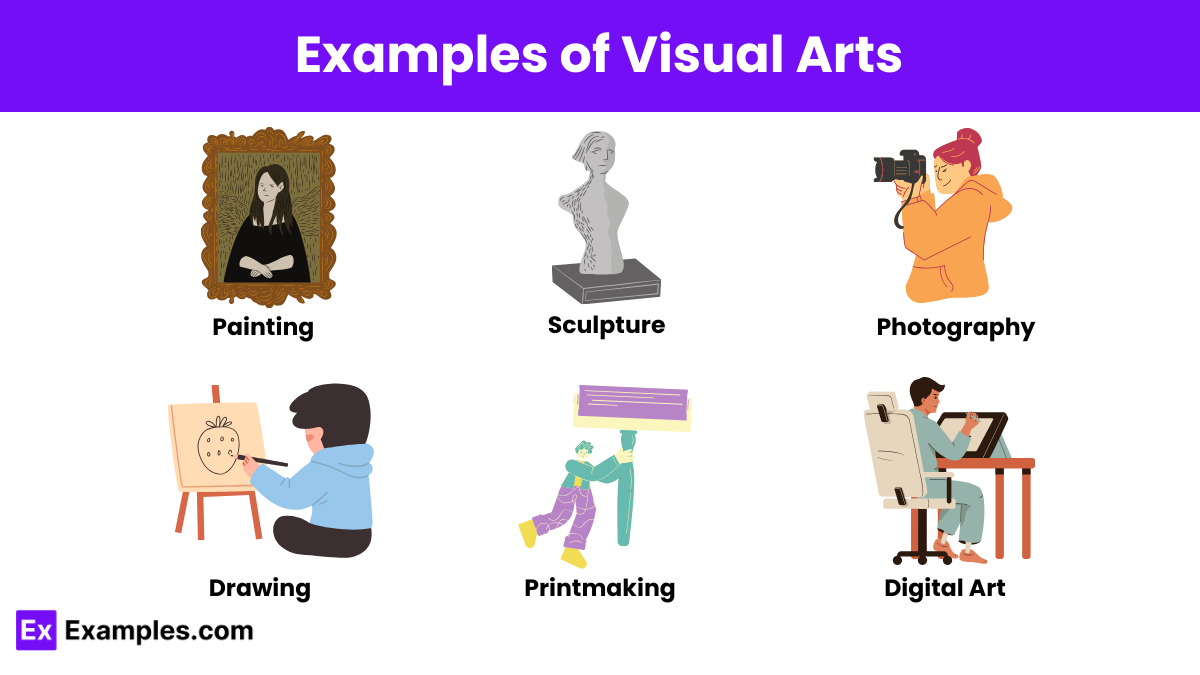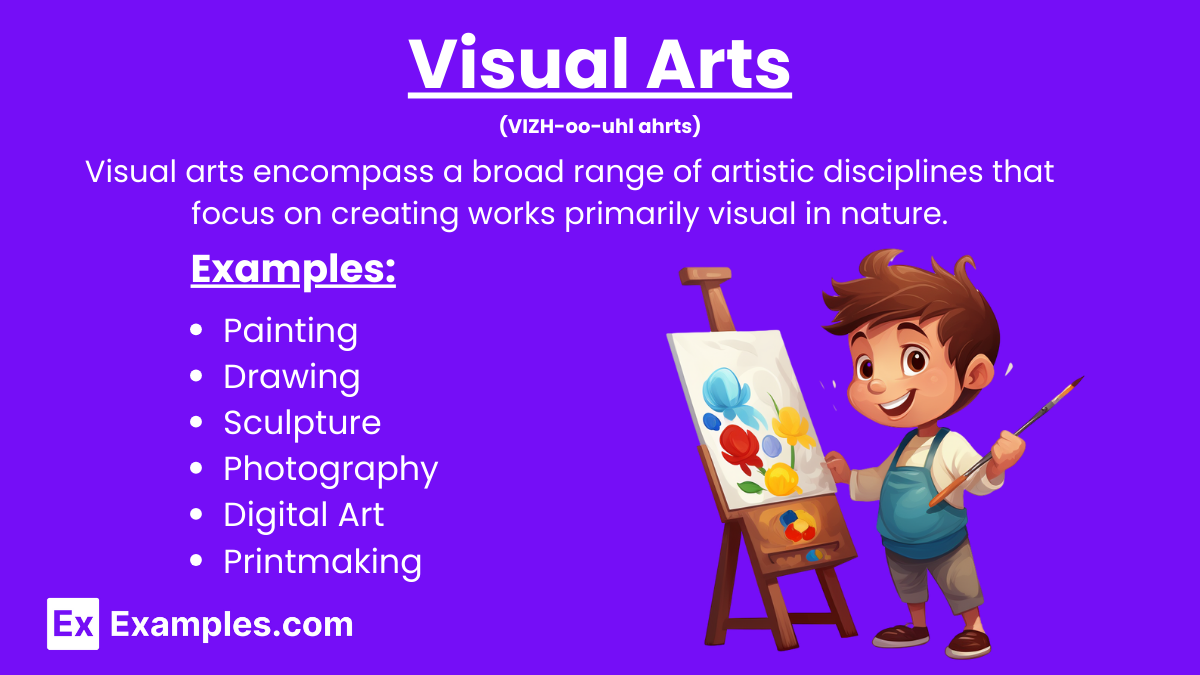15+ Visual Arts Examples to Download
Visual arts encompass a broad range of artistic disciplines that focus on creating works primarily visual in nature. This includes traditional forms like painting, drawing, and sculpture, as well as modern mediums such as photography, digital art, and mixed media. Writing an essay on art can explore these various disciplines, examining their techniques, history, and cultural significance. Visual communication journals delve into the ways in which visual elements are used to communicate ideas and information effectively. Additionally, developing an art lesson plan can help educators introduce students to different visual arts techniques and concepts, fostering their creativity and appreciation for art.
What is Visual Arts?
Examples of Visual Arts

- Painting
- Sculpture
- Photography
- Drawing
- Printmaking
- Ceramics
- Collage
- Textile Art
- Installation Art
- Digital Art
- Graffiti
- Calligraphy
- Stained Glass
- Mosaic
- Performance Art
Importance of Visual Arts
When developing an art gallery business plan, it is important to consider the cultural and economic impact of visual arts. An artist statement helps convey the artist’s vision and thematic focus, adding depth to their work. Exploring AI art prompt ideas can push the boundaries of creativity and innovation in art. Meanwhile, designing an Art Deco wedding invitation showcases the influence of visual arts on event planning and personal expression, highlighting the intersection of art and everyday life.
- Cultural Expression and Preservation: Visual arts capture and preserve cultural heritage, allowing communities to express their identities, traditions, and values through various forms of art such as painting, sculpture, and photography.
- Enhancing Creativity: Engaging with visual arts stimulates creativity and innovation, encouraging individuals to think outside the box and develop unique solutions to problems.
- Educational Benefits: Visual arts education promotes critical thinking, problem-solving, and observational skills. It also enhances cognitive abilities and academic performance in other subjects.
- Emotional Expression and Healing: Creating and appreciating visual art provides an outlet for emotional expression and can be therapeutic, aiding in mental health and emotional well-being.
- Economic Impact: The visual arts sector contributes significantly to the economy through the creation of jobs, the attraction of tourism, and the stimulation of related industries such as advertising, fashion, and design.
- Social Change and Advocacy: Visual arts can raise awareness and promote social change by addressing important issues, provoking thought, and inspiring action among audiences.
Uses of Visual Arts
- Cultural Expression: Visual arts serve as a means of cultural expression, reflecting the values, beliefs, and experiences of a society. Artists use visual mediums to convey their interpretations of cultural identity, traditions, and historical events.
- Communication: Visual arts are a powerful form of communication, transcending language barriers. They convey complex ideas, emotions, and messages through imagery, symbols, and visual storytelling, making them accessible to a global audience.
- Education: Visual arts are used in education to enhance learning and creativity. They help students develop critical thinking, problem-solving skills, and visual literacy. Art education encourages self-expression, cultural awareness, and appreciation for diverse perspectives.
- Therapy and Healing: Art therapy uses visual arts as a therapeutic tool to promote mental health and emotional well-being. Creating art helps individuals express emotions, reduce stress, and improve cognitive functions. It is used in various settings, including hospitals, rehabilitation centers, and mental health clinics.
- Social Commentary: Artists often use visual arts to comment on social, political, and environmental issues. Through their work, they raise awareness, provoke thought, and inspire change by addressing topics such as inequality, human rights, and climate change.
- Economic Contribution: Visual arts contribute to the economy by generating revenue through the sale of artworks, exhibitions, and cultural events. They also create jobs for artists, curators, art educators, and other professionals within the art industry.
- Aesthetic Enhancement: Visual arts enhance the aesthetic appeal of public and private spaces. Murals, sculptures, and installations transform environments, making them more engaging and enjoyable for the community.
- Preservation of History: Visual arts play a crucial role in preserving history and heritage. Historical paintings, photographs, and sculptures document significant events, people, and places, providing valuable insights into the past for future generations.
How do visual arts impact society?
Visual arts influence culture, provoke thought, inspire change, and contribute to the aesthetic value of environments.
What skills are needed for visual arts?
Skills needed include creativity, technical proficiency, attention to detail, and an understanding of color, composition, and design principles.
How can I start learning visual arts?
Start by taking art classes, practicing regularly, studying art history, and experimenting with different mediums and techniques.
What is the role of visual arts in education?
Visual arts foster creativity, critical thinking, problem-solving, and emotional expression in educational settings.
How do visual arts differ from performing arts?
Visual arts involve creating static or visual pieces, while performing arts involve live performances like dance, theater, and music.
Can anyone learn visual arts?
Yes, anyone can learn visual arts with practice, dedication, and the right guidance and resources.
What are some famous visual artists?
Famous visual artists include Leonardo da Vinci, Vincent van Gogh, Pablo Picasso, Frida Kahlo, and Andy Warhol.
How do digital tools influence visual arts?
Digital tools expand creative possibilities, allowing artists to create, edit, and share art digitally, enhancing accessibility and innovation.
What is the significance of art galleries?
Art galleries showcase artworks, support artists, provide a space for cultural exchange, and educate the public about visual arts.
How do visual arts reflect cultural identity?
Visual arts reflect cultural identity by depicting traditions, beliefs, and social issues, preserving and promoting cultural heritage.
15+ Visual Arts Examples to Download

Visual arts encompass a broad range of artistic disciplines that focus on creating works primarily visual in nature. This includes traditional forms like painting, drawing, and sculpture, as well as modern mediums such as photography, digital art, and mixed media. Writing an essay on art can explore these various disciplines, examining their techniques, history, and cultural significance. Visual communication journals delve into the ways in which visual elements are used to communicate ideas and information effectively. Additionally, developing an art lesson plan can help educators introduce students to different visual arts techniques and concepts, fostering their creativity and appreciation for art.
What is Visual Arts?
Visual arts refer to creative disciplines that focus on producing works primarily perceived through sight. This includes traditional methods such as painting, drawing, and sculpture, as well as contemporary practices like photography, digital art, and installation. Visual arts also extend to applied arts such as graphic design, fashion design, and interior design. These forms of art emphasize aesthetics, composition, and visual impact, aiming to evoke emotions, convey messages, or provide aesthetic pleasure.
An artist bio provides a brief overview of an artist’s background, achievements, and artistic journey. When applying for an art scholarship, a well-crafted art scholarship application is essential to showcase the artist’s skills and potential. Publications such as art magazines highlight current trends and notable works in the art world, offering inspiration and exposure to artists. An art portfolio is a curated collection of an artist’s best work, demonstrating their range and proficiency in various techniques and mediums.
Examples of Visual Arts
Painting
Sculpture
Photography
Drawing
Printmaking
Ceramics
Collage
Textile Art
Installation Art
Digital Art
Graffiti
Calligraphy
Stained Glass
Mosaic
Performance Art
Importance of Visual Arts
When developing an art gallery business plan, it is important to consider the cultural and economic impact of visual arts. An artist statement helps convey the artist’s vision and thematic focus, adding depth to their work. Exploring AI art prompt ideas can push the boundaries of creativity and innovation in art. Meanwhile, designing an Art Deco wedding invitation showcases the influence of visual arts on event planning and personal expression, highlighting the intersection of art and everyday life.
Cultural Expression and Preservation: Visual arts capture and preserve cultural heritage, allowing communities to express their identities, traditions, and values through various forms of art such as painting, sculpture, and photography.
Enhancing Creativity: Engaging with visual arts stimulates creativity and innovation, encouraging individuals to think outside the box and develop unique solutions to problems.
Educational Benefits: Visual arts education promotes critical thinking, problem-solving, and observational skills. It also enhances cognitive abilities and academic performance in other subjects.
Emotional Expression and Healing: Creating and appreciating visual art provides an outlet for emotional expression and can be therapeutic, aiding in mental health and emotional well-being.
Economic Impact: The visual arts sector contributes significantly to the economy through the creation of jobs, the attraction of tourism, and the stimulation of related industries such as advertising, fashion, and design.
Social Change and Advocacy: Visual arts can raise awareness and promote social change by addressing important issues, provoking thought, and inspiring action among audiences.
Uses of Visual Arts
Cultural Expression: Visual arts serve as a means of cultural expression, reflecting the values, beliefs, and experiences of a society. Artists use visual mediums to convey their interpretations of cultural identity, traditions, and historical events.
Communication: Visual arts are a powerful form of communication, transcending language barriers. They convey complex ideas, emotions, and messages through imagery, symbols, and visual storytelling, making them accessible to a global audience.
Education: Visual arts are used in education to enhance learning and creativity. They help students develop critical thinking, problem-solving skills, and visual literacy. Art education encourages self-expression, cultural awareness, and appreciation for diverse perspectives.
Therapy and Healing: Art therapy uses visual arts as a therapeutic tool to promote mental health and emotional well-being. Creating art helps individuals express emotions, reduce stress, and improve cognitive functions. It is used in various settings, including hospitals, rehabilitation centers, and mental health clinics.
Social Commentary: Artists often use visual arts to comment on social, political, and environmental issues. Through their work, they raise awareness, provoke thought, and inspire change by addressing topics such as inequality, human rights, and climate change.
Economic Contribution: Visual arts contribute to the economy by generating revenue through the sale of artworks, exhibitions, and cultural events. They also create jobs for artists, curators, art educators, and other professionals within the art industry.
Aesthetic Enhancement: Visual arts enhance the aesthetic appeal of public and private spaces. Murals, sculptures, and installations transform environments, making them more engaging and enjoyable for the community.
Preservation of History: Visual arts play a crucial role in preserving history and heritage. Historical paintings, photographs, and sculptures document significant events, people, and places, providing valuable insights into the past for future generations.
How do visual arts impact society?
Visual arts influence culture, provoke thought, inspire change, and contribute to the aesthetic value of environments.
What skills are needed for visual arts?
Skills needed include creativity, technical proficiency, attention to detail, and an understanding of color, composition, and design principles.
How can I start learning visual arts?
Start by taking art classes, practicing regularly, studying art history, and experimenting with different mediums and techniques.
What is the role of visual arts in education?
Visual arts foster creativity, critical thinking, problem-solving, and emotional expression in educational settings.
How do visual arts differ from performing arts?
Visual arts involve creating static or visual pieces, while performing arts involve live performances like dance, theater, and music.
Can anyone learn visual arts?
Yes, anyone can learn visual arts with practice, dedication, and the right guidance and resources.
What are some famous visual artists?
Famous visual artists include Leonardo da Vinci, Vincent van Gogh, Pablo Picasso, Frida Kahlo, and Andy Warhol.
How do digital tools influence visual arts?
Digital tools expand creative possibilities, allowing artists to create, edit, and share art digitally, enhancing accessibility and innovation.
What is the significance of art galleries?
Art galleries showcase artworks, support artists, provide a space for cultural exchange, and educate the public about visual arts.
How do visual arts reflect cultural identity?
Visual arts reflect cultural identity by depicting traditions, beliefs, and social issues, preserving and promoting cultural heritage.

